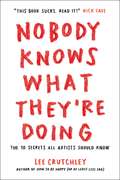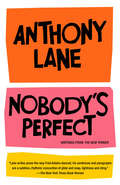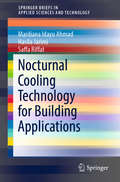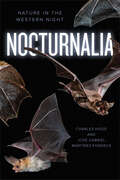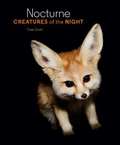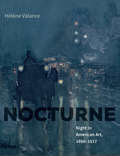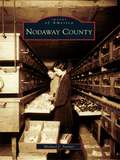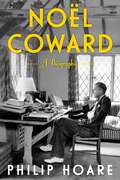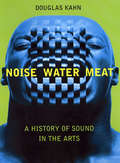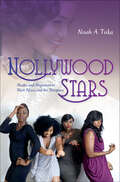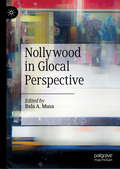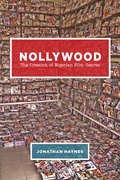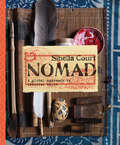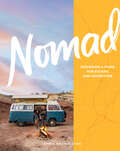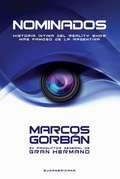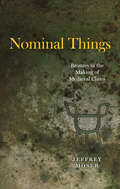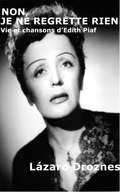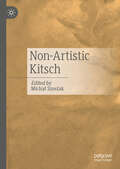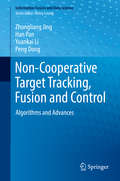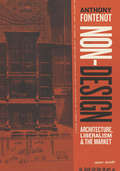- Table View
- List View
Nobody Knows What They're Doing: The 10 Secrets All Artists Should Know
by Lee CrutchleyEverything no one will tell you about being an artist Nobody Knows What They’re Doing is an honest guide to the creative life for artists of all kinds. Lee Crutchley, author of How to Be Happy (Or At Least Less Sad), skips the platitudes, positive affirmations, and guarantees of success; he'll never ever tell you to just Do What You Love. Instead, Crutchley discusses the things nobody else is talking about—that, frankly, your work sucks (but that’s ok because everyone else's does too), that making bad art is worth it, and so much more. In a world desperate for a glimpse of authenticity, Nobody Knows What They’re Doing is a breath of fresh air that reveals the truths hiding between the lines of Instagram-friendly aphorisms and behind the words of the most inspirational TED talks. An honest look at the reality of creativity and the joy and difficulty of crafting good (and bad) art, this book belongs in the hands of every exhausted creative, every starry-eyed dreamer, and every artist who is trying to make their way in the world—and keep a roof over their head while they do it.
Nobody's Perfect: Writings from The New Yorker
by Anthony LaneAnthony Lane on Con Air—“Advance word on Con Air said that it was all about an airplane with an unusually dangerous and potentially lethal load. Big deal. You should try the lunches they serve out of Newark. Compared with the chicken napalm I ate on my last flight, the men in Con Air are about as dangerous as balloons.”Anthony Lane on The Bridges of Madison County—“I got my copy at the airport, behind a guy who was buying Playboy’s Book of Lingerie, and I think he had the better deal. He certainly looked happy with his purchase, whereas I had to ask for a paper bag.” Anthony Lane on Martha Stewart—“Super-skilled, free of fear, the last word in human efficiency, Martha Stewart is the woman who convinced a million Americans that they have the time, the means, the right, and—damn it—the duty to pipe a little squirt of soft cheese into the middle of a snow pea, and to continue piping until there are ‘fifty to sixty’ stuffed peas raring to go.”For ten years, Anthony Lane has delighted New Yorker readers with his film reviews, book reviews, and profiles that range from Buster Keaton to Vladimir Nabokov to Ernest Shackleton. Nobody’s Perfect is an unforgettable collection of Lane’s trademark wit, satire, and insight that will satisfy both the long addicted and the not so familiar.
Nocturnal Cooling Technology for Building Applications (SpringerBriefs in Applied Sciences and Technology)
by Mardiana Idayu Ahmad Saffa Riffat Hasila JarimiThis book discusses nocturnal cooling technologies for building applications. Exploiting the natural environment as a renewable and sustainable resource has become a significant strategy for passive energy saving in buildings, and has led to growing interest in the use of passive radiative cooling based on nighttime (nocturnal) and daytime (diurnal) operating periods. Of these, nocturnal cooling is more promising since diurnal cooling is hard to achieve due to the solar radiation effect. As such, this book provides a comprehensive overview of nocturnal cooling for building applications, including a definition, concepts and principles; materials and devices; and cooling systems and configurations.
Nocturnalia: Nature in the Western Night
by Charles Hood José Gabriel Martínez-FonsecaDon’t be afraid of the dark: grab a flashlight and rediscover your sense of adventure!Darkness is something humans strive to keep at bay, but under the glow of twilight a nocturnal universe stirs to life. Nightshade blossoms bloom, javelinas parade down city streets, fox eyes gleam under the cover of the forest, and tiny sparrows fly incredible distances, guided by the stars. Naturalist Charles Hood and bat biologist José Gabriel Martínez-Fonseca unravel these enigmas in Nocturnalia, inviting readers on an environmental romp through the wonders of the Wild West. Their sundown dispatches, featuring over 100 photographs from California and the American Southwest, take us from the astronomical canopy overhead, to the flora that unfurl under moonshine, to the creatures that go bump in the night. With practical tips for the budding nighttime naturalist, the authors invite citizen scientists of all stripes to expand our knowledge of this final frontier and our understanding of life on Earth. Exploring the evolutionary adaptations of owls, bats, and other nightlife animals; the natural history of nighttime plants; and the celestial patterns that regulate this after-dark kingdom, Hood and Martínez-Fonseca lift their lanterns to illuminate the exquisite and intricate inner workings of nature after nightfall.
Nocturne
by Traer ScottWhether fierce, cuddly, startling, mysterious, or some indefinable combination of all of the above, nocturnal animals never fail to fascinate. In Nocturne: Creatures of the Night, celebrated animal photographer Traer Scott takes the viewer on a journey through nighttime in the animal kingdom, revealing some of nature's most elusive creatures. Bats, big cats, flying squirrels, tarantula, owls, kangaroo mice, giant moths, sloth, several species of snakes, and a Madagascar hissing cockroach are only a few of the animals illuminated in these lushly detailed portraits. Seventy-five full-color photographs of forty different species are accompanied by informed but accessible descriptions of each animal's habits and habitats, and an introduction provides personal insight into how Scott captures her astonishing images. Nocturne is a compelling view of the rarely seen darkness dwellers who populate the night.
Nocturne: Night in American Art, 1890-1917
by Jane Marie Todd Hélène ValanceA beautifully illustrated look at the vogue for night landscapes amid the social, political, and technological changes of modern America The turn of the 20th century witnessed a surge in the creation and popularity of nocturnes and night landscapes in American art. In this original and thought-provoking book, Hélène Valance investigates why artists and viewers of the era were so captivated by the night. Nocturne examines works by artists such as James McNeill Whistler, Childe Hassam, Winslow Homer, Frederic Remington, Edward Steichen, and Henry Ossawa Tanner through the lens of the scientific developments and social issues that dominated the period. Valance argues that the success of the genre is connected to the resonance between the night and the many forces that affected the era, including technological advances that expanded the realm of the visible, such as electric lighting and photography; Jim Crow–era race relations; America’s closing frontier and imperialism abroad; and growing anxiety about identity and social values amid rapid urbanization. This absorbing study features 150 illustrations encompassing paintings, photographs, prints, scientific illustration, advertising, and popular media to explore the predilection for night imagery as a sign of the times.
Nodaway County
by Michael J. SteinerOne of six counties carved out of the Platte Purchase, added to Missouri in 1836, Nodaway County appeared to its first white explorers to be a rolling prairie, marginal for agriculture but full of opportunity for those willing to bring hard work and ingenuity to the land. Within a generation of building cabins and experimenting with a wide variety of agricultural enterprises, the county boasted at least 17 towns, four railroad lines, 16 newspapers, and all the economic and cultural institutions necessary for boosters to lay claim to progress and civility. While residents of towns and the countryside often drew distinctions between one another, their lives were intertwined by mills, horse farms, livestock shows, new technology, churches, schools, public entertainment of every sort, and occasional times of hardship. By the 1920s, the communities of Nodaway County, supported by a vibrant and diverse rural economy, reached a zenith of locally generated economic growth and community activity, captured artfully by photographers during the decades that bracketed the turn of the 20th century.
Noel Coward: A Biography of Noel Coward
by Philip HoareThe definitive biography of one of the 20th century&’s most celebrated and controversial dramatists.To several generations, actor, playwright, songwriter, and filmmaker Noël Coward (1899–1973) was the very personification of wit, glamour, and elegance. Given unprecedented access to the private papers and correspondence of Coward family members, compatriots, and numerous lovers, Samuel Johnson Prize–winning biographer Philip Hoare has produced an illuminating and sophisticated biography of Coward, whose relentless drive for success and approval fueled the stunning bursts of creativity that launched the once-painfully middle class boy from the suburbs of London into a pantheon of theatrical deities that includes Gilbert and Sullivan, Oscar Wilde, and George Bernard Shaw. As much the embodiment of a lifestyle as an actual inhabitant of it, Coward&’s carefully cultivated image defined the aspirations of untold numbers of actors, artists, and writers who succeeded him, and Hoare&’s meticulously researched biography peels away the layers of this complex persona to reveal the man underneath it all, whom The Times (London) decreed upon his death to be the most versatile of all the great figures of the English theater.
Noir Affect
by Christopher Breu and Elizabeth A. HatmakerNoir Affect proposes a new understanding of noir as defined by negative affect. This new understanding emphasizes that noir is, first and foremost, an affective disposition rather than a specific cycle of films or novels associated with a given time period or national tradition. Instead, the essays in Noir Affect trace noir’s negativity as it manifests in different national contexts from the United States to Mexico, France, and Japan and in a range of different media, including films, novels, video games, and manga.The forms of affect associated with noir are resolutely negative: These are narratives centered on loss, sadness, rage, shame, guilt, regret, anxiety, humiliation, resentment, resistance, and refusal. Moreover, noir often asks us to identify with those on the losing end of cultural narratives, especially the criminal, the lost, the compromised, the haunted, the unlucky, the cast-aside, and the erotically “perverse,” including those whose greatest erotic attachment is to death. Drawing on contemporary work in affect theory, while also re-orienting some of its core assumptions to address the resolutely negative affects narrated by noir, Noir Affect is invested in thinking through the material, bodily, social, and political–economic impact of the various forms noir affect takes.If much affect theory asks us to consider affect as a space of possibility and becoming, Noir Affect asks us to consider affect as also a site of repetition, dissolution, redundancy, unmaking, and decay. It also asks us to consider the way in which the affective dimensions of noir enable the staging of various forms of social antagonism, including those associated with racial, gendered, sexual, and economic inequality. Featuring an Afterword by the celebrated noir scholar Paula Rabinowitz and essays by an array of leading scholars, Noir Affect aims to fundamentally re-orient our understanding of noir.Contributors: Alexander Dunst, Sean Grattan, Peter Hitchcock, Justus Nieland, Andrew Pepper, Ignacio Sánchez Prado, Brian Rejack, Pamela Thoma, Kirin Wachter-Grene
Noise Channels: Glitch and Error in Digital Culture (Electronic Mediations)
by Peter KrappTo err is human; to err in digital culture is design. In the glitches, inefficiencies, and errors that ergonomics and usability engineering strive to surmount, Peter Krapp identifies creative reservoirs of computer-mediated interaction. Throughout new media cultures, he traces a resistance to the heritage of motion studies, ergonomics, and efficiency; in doing so, he shows how creativity is stirred within the networks of digital culture. Noise Channels offers a fresh look at hypertext and tactical media, tunes into laptop music, and situates the emergent forms of computer gaming and machinima in media history. Krapp analyzes text, image, sound, virtual spaces, and gestures in noisy channels of computer-mediated communication that seek to embrace—rather than overcome—the limitations and misfires of computing. Equally at home with online literature, the visual tactics of hacktivism, the recuperation of glitches in sound art, electronica, and videogames, or machinima as an emerging media practice, he explores distinctions between noise and information, and how games pivot on errors at the human–computer interface. Grounding the digital humanities in the conditions of possibility of computing culture, Krapp puts forth his insight on the critical role of information in the creative process.
Noise, Water, Meat: A History of Sound in the Arts (The\mit Press Ser.)
by Douglas KahnAn examination of the role of sound in twentieth-century arts.This interdisciplinary history and theory of sound in the arts reads the twentieth century by listening to it—to the emphatic and exceptional sounds of modernism and those on the cusp of postmodernism, recorded sound, noise, silence, the fluid sounds of immersion and dripping, and the meat voices of viruses, screams, and bestial cries. Focusing on Europe in the first half of the century and the United States in the postwar years, Douglas Kahn explores aural activities in literature, music, visual arts, theater, and film. Placing aurality at the center of the history of the arts, he revisits key artistic questions, listening to the sounds that drown out the politics and poetics that generated them. Artists discussed include Antonin Artaud, George Brecht, William Burroughs, John Cage, Sergei Eisenstein, Fluxus, Allan Kaprow, Michael McClure, Yoko Ono, Jackson Pollock, Luigi Russolo, and Dziga Vertov.
Nollywood Stars: Media And Migration In West Africa And The Diaspora (New Directions In National Cinemas Ser.)
by Noah A. TsikaIn this comprehensive study of Nollywood stardom around the world, Noah A. Tsika explores how the industry's top on-screen talents have helped Nollywood to expand beyond West Africa and into the diaspora to become one of the globe's most prolific and diverse media producers. Carrying VHS tapes and DVDs onto airplanes and publicizing new methods of film distribution, the stars are active agents in the global circulation of Nollywood film. From Omotola Jalade-Ekeinde's cameo role on VH1's popular series Hit the Floor to Oge Okoye's startling impersonation of Lady Gaga, this book follows Nollywood stars from Lagos to London, Ouagadougou, Cannes, Paris, Porto-Novo, Sekondi-Takoradi, Dakar, Accra, Atlanta, Houston, New York, and Los Angeles. Tsika tracks their efforts to integrate into various entertainment cultures, but never to the point of effacing their African roots.
Nollywood in Glocal Perspective
by Bala A. MusaThis book gives a panoramic view of the rise and growth of Nollywood, Nigeria’s movie and home video entertainment industry, into the second largest and most prolific movie-producing industry in the world. It offers an analysis of Nollywood’s influence as a local and global cultural force. Scholars from Africa, the African Diaspora and beyond examine the factors that have shaped Nollywood’s unique story-telling, production, and distribution system. The volume shows how internal and external economic, social, cultural and technological changes intersect to define Nollywood’s film-making and entertainment ethos. It is grounded in sound theoretical perspectives that help readers understand the texts and subtexts of the industry’s emergence, transformation, and impact. The range of subjects covered span Nollywood’s historical roots in Nigeria pre-colonial traveling/community theatre to colonial era film-making, and its contemporary spin-offs and inspired cousins across Africa and in Europe. It illuminates the interface of artistic, business, cultural and technological innovation and creativity at the heart of Africa’s local and global pop culture explosion.
Nollywood: The Creation of Nigerian Film Genres
by Jonathan HaynesNigeria's Nollywood has rapidly grown into one of the world's largest film industries, radically altering media environments across Africa and in the diaspora; it has also become one of African culture's most powerful and consequential expressions, powerfully shaping how Africans see themselves and are seen by others. With this book, Jonathan Haynes provides an accessible and authoritative introduction to this vast industry and its film culture. Haynes describes the major Nigerian film genres and how they relate to Nigerian society--its values, desires, anxieties, and social tensions--as the country and its movies have developed together over the turbulent past two decades. As he shows, Nollywood is a form of popular culture; it produces a flood of stories, repeating the ones that mean the most to its broad audience. He interprets these generic stories and the cast of mythic figures within them: the long-suffering wives, the business tricksters, the Bible-wielding pastors, the kings in their traditional regalia, the glamorous young professionals, the emigrants stranded in New York or London, and all the rest. Based on more than twenty years of research, Haynes's survey of Nollywood's history and genres is unprecedented in scope, while his book also vividly describes landmark films, leading directors, and the complex character of this major branch of world cinema.
Nollywood: The Creation of Nigerian Film Genres
by Jonathan HaynesNigeria's Nollywood has rapidly grown into one of the world's largest film industries, radically altering media environments across Africa and in the diaspora; it has also become one of African culture's most powerful and consequential expressions, powerfully shaping how Africans see themselves and are seen by others. With this book, Jonathan Haynes provides an accessible and authoritative introduction to this vast industry and its film culture. Haynes describes the major Nigerian film genres and how they relate to Nigerian society--its values, desires, anxieties, and social tensions--as the country and its movies have developed together over the turbulent past two decades. As he shows, Nollywood is a form of popular culture; it produces a flood of stories, repeating the ones that mean the most to its broad audience. He interprets these generic stories and the cast of mythic figures within them: the long-suffering wives, the business tricksters, the Bible-wielding pastors, the kings in their traditional regalia, the glamorous young professionals, the emigrants stranded in New York or London, and all the rest. Based on more than twenty years of research, Haynes's survey of Nollywood's history and genres is unprecedented in scope, while his book also vividly describes landmark films, leading directors, and the complex character of this major branch of world cinema.
Nomad: A Global Approach to Interior Style
by Sibella Court“A rich-tapestry celebration of [Court’s] meanderings—from Japan to Italy, Syria to Mexico and India . . . Essential for anyone who adores travel.” —Australian Women OnlineIn this deluxe guide, celebrated designer Sibella Court travels the world in search of eclectic inspiration. She explores far-flung destinations and captures the essence of each in small details, exotic color palettes, exquisite textures, and traditional crafts. Along the way, she shows readers how to incorporate these elements into interiors and how to replicate the ideas in their own spaces. Overflowing with imaginative ideas from across the globe with breathtaking photos of each destination accompanied by examples of gorgeous real-life interiors, plus tips for applying the looks at home Nomad promises to serve as the ultimate lookbook for designers and wanderers the world over.“Stylist Sibella Court shows us how to bring our travels home with us in the most unexpected of ways. She has travelled to Syria, Mexico, Italy, India and Japan to be inspired by everything from door knobs and street signs to roadside shrines and household brooms. The ideas, photographs and mementos she collected are used to inspire room settings, illustrating simple, practical and surprising ways to be reminded of your travel experiences.” —The House Directory“Sibella Court shows us how to incorporate the objects you collected during your travels in your interior. Again, this is not a step-by-step book but rather a book to get ideas and make them your own. It also makes you aware of what to bring with you from your journeys be it textiles, traditional crafts or small details that capture the essence of a foreign place.” —30s Magazine
Nomad: Designing a Home for Escape and Adventure
by Emma ReddingtonA reclusive designer living in a custom tiny house in the middle of the Montana wilderness. A couple who traded their expensive Bay Area apartment for a slip at a nearby marina, where they live on a docked sailboat. A family of five who decided to simplify their lives by moving into a school bus, selling most of their possessions in the process. Nomad features their stories, and many more. From vanlifers to boondockers, liveaboards to tiny-house dwellers, these freedom seekers have forged a new way of life for themselves—one that values experiences over things, is environmentally conscious, and is often more budget-friendly than their &“rooted&” lives ever were. The ubiquity of the internet has ushered in a new era of connectivity that makes working from an Airstream beside a roaring river or running a photography business from a mountaintop a reality. It&’s now possible to do whatever you want from wherever you want and still have a foothold in the world. This book shows you how, with tours of 26 unconventional homes and the people who live in them, plus all the information you need to make your own off-the-grid dream a reality. There are chapters on bathroom and storage—two of the most challenging aspects of this lifestyle—plus a comprehensive guide to finding the right home, assessing the cost of renovation, handy products for small spaces, and indispensable resources (including sources for replacement RV parts, portable power solutions, tiny wood stoves, and much more).
Nominados: Historia íntima del reality show más famoso de la Argentina
by Marcos GorbanHistoria íntima del reality show más famoso de la Argentina. Gran Hermano es el reality show más importante del mundo. El de mayoresaudiencias, el de mayor facturación, el que más fantasías despierta. ¿Los drogan? ¿Les dan alcohol para que tengan sexo? ¿Está todo arreglado?¿Por qué están tomando sol todo el día sin hacer nada? ¿Están guionados?Los mitos que se tejieron alrededor del programa son muchos. Y han idocambiando a través de los años. Pero hay muchas historias que el públicoy la prensa desconocen. ¿Cuál fue la trastienda de los castings, de lasgalas en vivo, de las decisiones que más impacto tuvieron, desde laconfesión de homosexualidad de Gastón hasta la inclusión de un expresidiario en 2007?
Nominal Things: Bronzes in the Making of Medieval China
by Jeffrey MoserHow the medieval study of ancient bronzes influenced the production of knowledge and the making of things in East Asia. This book opens in eleventh-century China, where scholars were the first in world history to systematically illustrate and document ancient artifacts. As Jeffrey Moser argues, the visual, technical, and conceptual mechanisms they developed to record these objects laid the foundations for methods of visualizing knowledge that scholars throughout early modern East Asia would use to make sense of the world around them. Of the artifacts these scholars studied, the most celebrated were bronze ritual vessels that had been cast nearly two thousand years earlier. While working to make sense of the relationship between the bronzes’ complex shapes and their inscribed glyphs, they came to realize that the objects were “nominal things”—objects inscribed with names that identified their own categories and uses. Eleventh-century scholars knew the meaning of these glyphs from hallowed Confucian writings that had been passed down through centuries, but they found shocking disconnects between the names and the bronzes on which they were inscribed. Nominal Things traces the process by which a distinctive system of empiricism was nurtured by discrepancies between the complex materiality of the bronzes and their inscriptions. By revealing the connections between the new empiricism and older ways of knowing, the book explains how scholars refashioned the words of the Confucian classics into material reality.
Non c’è niente da pagare! Ottenete Tutto Gratuitamente...
by Simona Trapani Bernard LevinePREMIATEVI CON TANTISSIMI DONI GRATUITI OGGI! Prendete tutto ciò che volete...è tutto gratis! Non crederete ai vostri occhi quando vedrete quello che potete ottenere gratuitamente. Questo libro è pieno di doni totalmente gratuiti solo per voi. Vi troverete di tutto, dai mobili gratuiti, al caffè e al tè gratis, così come i vestiti e persino autografi delle celebrità, carta da parati in omaggio, giocattoli, oggetti per la casa tra cui alberi e piante da giardino, fotocamere digitali e anche vernice gratis! .... E tanti, tanti altri doni gratuiti sono per voi! Il valore di tutti questi prodotti gratis è di migliaia di dollari.... E sono tutti i vostri... Gratuitamente e senza alcun costo... non c'è niente da pagare....prendeteli tutti, godeteveli e divertitevi! Questo libro vi renderà molto felici e vi farà sorridere.
Non, je ne regrette rien
by Lázaro Droznes Guillermo Cabello GarciaEdith Piaf est l'un des mythes les plus vivaces de la musique française et mondiale. Née littéralement dans la rue, elle développa une carrière de chanteuse et compositrice qui l'amena à devenir une icône mondiale d'une importance exceptionnelle. Ce spectacle est une reconstitution de ses récitals historiques à l'Olympia entrecoupés par des histoires et anecdotes de sa vie qui reflètent sa passion pour la musique, pour la vie et pour les hommes. Elle vécut sa vie en repoussant toujours les limites, défiant tout et risquant tout. Elle vécut comme elle chanta: en soumettant son petit corps à l'extrême de ses possibilités. Et elle ne regretta rien.
Non-Artistic Kitsch
by Michał SzostakThe book aims to provide a contemporary individual with an extensive but focused set of examples of kitsch in non-artistic spheres to create theoretical and practical backgrounds for conscious recognition of kitsch in fields like psychology, education, politics, law, religion, terrorism, television, or journalism. Two perspectives are underlined: 1) the consciousness of the presence and role of kitsch experience within the philosophy of living and 2) the management of kitsch experience within the philosophy of living (kitsch as a means for achieving goals). Due to the diverse topics covered by particular chapters, no unified methodology is applied in the whole volume. However, due to the kitsch’s complex and metaphysical character, the only fundament is using the “kitsch experience theory” (Szostak and Sułkowski, 2020) to narrate the volume coherently. The authors apply a qualitative methodological approach, extensively using case studies, comparative analyses, and ethnographic focus.
Non-Cooperative Target Tracking, Fusion and Control: Algorithms and Advances (Information Fusion and Data Science)
by Zhongliang Jing Han Pan Yuankai Li Peng DongThis book gives a concise and comprehensive overview of non-cooperative target tracking, fusion and control. Focusing on algorithms rather than theories for non-cooperative targets including air and space-borne targets, this work explores a number of advanced techniques, including Gaussian mixture cardinalized probability hypothesis density (CPHD) filter, optimization on manifold, construction of filter banks and tight frames, structured sparse representation, and others. Containing a variety of illustrative and computational examples, Non-cooperative Target Tracking, Fusion and Control will be useful for students as well as engineers with an interest in information fusion, aerospace applications, radar data processing and remote sensing.
Non-Design: Architecture, Liberalism, and the Market
by Anthony FontenotAnthony Fontenot’s staggeringly ambitious book uncovers the surprisingly libertarian heart of the most influential British and American architectural and urbanist discourses of the postwar period, expressed as a critique of central design and a support of spontaneous order. Non-Design illuminates the unexpected philosophical common ground between enemies of state support, most prominently the economist Friedrich Hayek, and numerous notable postwar architects and urbanists like Robert Venturi, Denise Scott Brown, Reyner Banham, and Jane Jacobs. These thinkers espoused a distinctive concept of "non-design,"characterized by a rejection of conscious design and an embrace of various phenomenon that emerge without intention or deliberate human guidance. This diffuse and complex body of theories discarded many of the cultural presuppositions of the time, shunning the traditions of modern design in favor of the wisdom, freedom, and self-organizing capacity of the market. Fontenot reveals the little-known commonalities between the aesthetic deregulation sought by ostensibly liberal thinkers and Hayek’s more controversial conception of state power, detailing what this unexplored affinity means for our conceptions of political liberalism. Non-Design thoroughly recasts conventional views of postwar architecture and urbanism, as well as liberal and libertarian philosophies.
Non-Design: Architecture, Liberalism, and the Market
by Anthony FontenotAnthony Fontenot’s staggeringly ambitious book uncovers the surprisingly libertarian heart of the most influential British and American architectural and urbanist discourses of the postwar period, expressed as a critique of central design and a support of spontaneous order. Non-Design illuminates the unexpected philosophical common ground between enemies of state support, most prominently the economist Friedrich Hayek, and numerous notable postwar architects and urbanists like Robert Venturi, Denise Scott Brown, Reyner Banham, and Jane Jacobs. These thinkers espoused a distinctive concept of "non-design,"characterized by a rejection of conscious design and an embrace of various phenomenon that emerge without intention or deliberate human guidance. This diffuse and complex body of theories discarded many of the cultural presuppositions of the time, shunning the traditions of modern design in favor of the wisdom, freedom, and self-organizing capacity of the market. Fontenot reveals the little-known commonalities between the aesthetic deregulation sought by ostensibly liberal thinkers and Hayek’s more controversial conception of state power, detailing what this unexplored affinity means for our conceptions of political liberalism. Non-Design thoroughly recasts conventional views of postwar architecture and urbanism, as well as liberal and libertarian philosophies.
